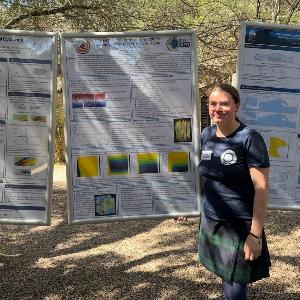Mysterious Fingers in the Earth's Core
22 May 2025
How Earth's rotation and magnetic field alter convection patterns at the top of the Earth's outer core
22 May 2025
How Earth's rotation and magnetic field alter convection patterns at the top of the Earth's outer core

© Carolin Weber
Deep within the Earth, the outer core is in constant motion: fluid iron, mixed with a small amount of other elements, convects, generating our planet's magnetic field. However, measurements suggest that at the very top of the core, there appears to be a stable, quieter layer. This is likely because the temperature there increases too slowly with depth to allow for convection (subadiabatic temperature stratification). However, despite this stable stratification, tiny movements resembling small fingers can arise.
The Formation of Finger Convection
Finger convection occurs as a specific form of double-diffusive convection that was first investigated and described in oceanography. Diffusion is the movement of particles from an area of higher concentration to an area of lower concentration until they are evenly distributed. Double-diffusive means that the density of the medium depends on two different properties that diffuse at different rates: in ocean water, these are typically temperature and salinity. Heat diffuses much faster in water than salt. Consequently, when warmer, saltier water lies above colder, less salty water, and a small parcel of the warmer, saltier water slightly sinks, it loses its heat to the surrounding colder water more quickly than its salinity can equalize: this water parcel then becomes denser than its surroundings and continues to sink, forming a long, thin a finger growing downwards. The opposite happens with rising cold, less salty water. This process creates many small, vertical currents that look like fingers and transport heat and salt vertically. More recently, finger convection has also been intensively studied in astrophysics. Here, too, temperature differences and varying concentrations of chemical elements can trigger these specific convection patterns.
Rotation and Magnetic Field as Disturbing Factors
For her doctoral thesis, Carolin Weber investigates whether the existing knowledge about finger convection can be directly applied to the Earth's core. Both the Earth's rotation and its magnetic field can influence these movements. This makes the calculations for the Earth's core far more complex. At the Mathematical Fluid Dynamics Advanced Summer School (March 31 - April 12, 2025 in Cargèse, Corsica), Carolin presented the results of her initial calculations and computer simulations: the Earth's rotation and its magnetic field significantly alter the shape of the fingers and how quickly they grow.
Simulations Reveal: Tilted Fingers and Altered Material Transport
In the presence of a strong magnetic field, the dominant finger movements are no longer moving purely upwards and downwards, nor do they resemble round fingers. Instead, they look more like tilted thin sheets. Thus, the resulting material and heat transport in the outer core is no longer purely vertical. The speed at which these sheets grow also decreases as the magnetic field becomes stronger and as one gets closer to the equator.
New Forms of Motion in the Outer Core
In short: The Earth's rotation and especially a strong magnetic field "tilt" and slow down these tiny movements in the Earth's core, making material transport more complicated than just a simple up and down. The shape of the movements changes from "fingers" to more "sheet-like" structures.
What do the Sheet-Like Fingers Mean for the Earth's Magnetic Field?
Next, Carolin wants to find out how these small fingers could influence the formation of larger structures within the Earth's core. She wants to better understand how this stable layer changes over very long geological timescales and how it influences the geodynamo, and thus the Earth's magnetic field.
Magneto-rotating finger convection in stable layers at the top of Earth’s core
Carolin Weber, Stephan Stellmach
Institute of Geophysics, University of Münster
While most of the Earth’s fluid outer core is vigorously convecting, there is evidence for a stably stratified layer at its very top. This stable layer is often assumed to be a result of a sub-adiabatic thermal stratification, which overcompensates a destabilizing compositional gradient. In such a scenario, small scale double-diffusive modes known as finger instabilities are likely to be excited. Fingering convection has been studied extensively in oceanography and more recently in astrophysics, but little work has been done so far in the context of planetary cores, where both rotational and magnetic effects complicate the dynamics. In this study, we investigate whether or not the pre-existing knowledge on finger convection can be directly applied to the Earth’s core. Our linear stability analysis, confirmed by some first direct numerical simulations, reveals that both the morphology and the growth rates of the fingers are significantly affected by the combined effect of rotation and magnetic field. For a large range of latitudes, we observe a shift away from purely vertically moving, horizontally isotropic fingers to tilted, sheet-like structures. We are currently investigating what implications this has for possible large-scale structure formation. The final goal is to contribute to a better understanding of the internal dynamics within the stably stratified layer, such that its evolution over geological time scales and its effect on the geodynamo becomes clearer.
Magneto-rotating finger convection in stable layers at the top of Earth’s core. Carolin Weber, Stephan Stellmach. Mathematical Fluid Dynamics Advanced Summer School 2025, Cargèse, Corsica, March 31 - April 12 2025.